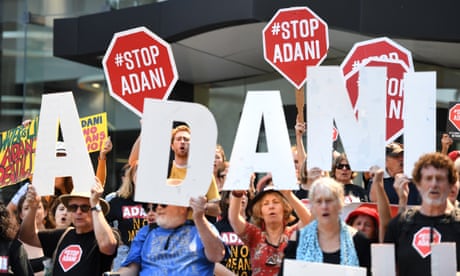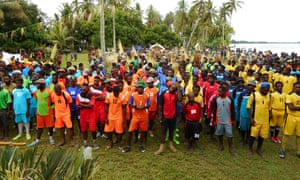A gold and copper mine proposed for the Sepik region in Papua New Guineaby an Australian-based company threatens to destroy the health of a major river system, poison fish stocks and cause violent unrest, a report has found.
The Chinese-owned company, PanAust, says the Frieda river project could have a 45-year life span and generate A$12.45bn in tax, royalties and production levies for the PNG government and landholders.
But the report, from research centre Jubilee Australia and Project Sepik, raises serious environmental and social concerns about the mine.
“The lack of information released by the company about its environmental management plans are continuing to cause uncertainty about whether the company’s environmental management plans will be fit for purpose,” it says.

Adani cleared to start Carmichael coalmine work as groundwater plans approved
Read more
“The potential for this project to lead to damaging social conflict and unrest is real and must be taken seriously.”
Papua New Guinea has a chequered mining history, including an environmental disaster when the BHP Ok Tedi copper mine’s tailings dam failed and the decade-long civil war on Bougainville, which was triggered by the Rio Tinto majority-owned Panguna copper mine and cost an estimated 20,000 lives.
The report notes that one of the PanAust project’s biggest challenges will be building a safe storage facility for the mine’s tailings (waste material left over after separating the valuable mineral from the ore) to prevent acid rock drainage.
That occurs when mine waste is exposed to oxygen and produces sulphuric acid, which dissolves heavy metals such as mercury from nearby rocks, which can then leach into rivers.
The report says the size of the ore body, combined with the relatively low grade of copper in the deposit, means the mine will generate substantial tailings.

Advertisement
“The inaccessibility of the terrain will pose challenges when it comes to finding a large enough site or sites for storage,” it says.
“The extremely high rainfall in the area and the fact that the area is a site of seismic activity add to the risks of a dam collapse. The technical complexity of the feat facing the mining engineers, the extremely large costs involved, and the weather and seismic situation all adds up to a very expensive environmental management problem and one with considerable risks.”

BHP reveals five mine dams at ‘extreme’ risk of causing damage and loss of life
Read more
Locals also have concerns about environmental damage from an increase in the number of large vessels operating on the Freida river.
PanAust promised in April it would shortly release an environmental impact statement to nearby villages, but researchers say it has not done so.
In response to to questions from Guardian Australia, the company said PanAust had not received a copy of the Jubilee report and “as such, the company is not in a position to comment on its contents”.
It did however say that PanAust had submitted its plans and an environmental impact statement to PNG regulators and was working with them on its approval.
The report also accused PanAust of a flawed consultation process with indigenous communities downstream from the mine which has created an “atmosphere of animosity and lack of trust” and resulted in acts of sabotage.
“There are reports of official (mainly police) intimidation of anti-mine activists,” the report says.

“In 2017 a youth leader from Oum 2 village led a group of young men to attack a tugboat and pontoon with homemade wire sling shots.”Advertisement
In October researchers visited 23 nearby villages, where locals repeatedly raised concerns about river and fish health as a result of increased sedimentation from increased tugboat traffic connected with the project.
The Freida river joins the 1,126km Sepik river, which flows across the provinces of West Sepik and East Sepik provinces.
The local economy is built on the sale of sago (starch from a tropical palm stem), fish, freshwater prawn, eels, turtles and crocodile eggs. Crocodiles are also harvested for their skins and teeth. Locals are worried about the mine affecting their food security, the report says.
In a company announcement in December, PanAust characterised the mine project as a “nation building development”.
It has promised 5,000 jobs in construction and 2,100 in mining, and estimates there may be 30,000 more indirect jobs.
“Host communities, especially in rural areas, will benefit from access to improved transport, telecommunications, health, education and government services that will support a higher quality of life and greater social participation,” the company said.
“More broadly, training and employment of Papua New Guineans will provide the skills and capacity to support the nation’s future development and prosperity.”
The company said a final investment decision would be linked to financing and fiscal terms agreed with the PNG government during the approvals phase.
As the crisis escalates…
… in our natural world, we refuse to turn away from the climate catastrophe and species extinction. For The Guardian, reporting on the environment is a priority. We give reporting on climate, nature and pollution the prominence it deserves, stories which often go unreported by others in the media. At this pivotal time for our species and our planet, we are determined to inform readers about threats, consequences and solutions based on scientific facts, not political prejudice or business interests.
More people are reading and supporting The Guardian’s independent, investigative journalism than ever before. And unlike many new organisations, we have chosen an approach that allows us to keep our journalism accessible to all, regardless of where they live or what they can afford. But we need your ongoing support to keep working as we do.
The Guardian will engage with the most critical issues of our time – from the escalating climate catastrophe to widespread inequality to the influence of big tech on our lives. At a time when factual information is a necessity, we believe that each of us, around the world, deserves access to accurate reporting with integrity at its heart.
Our editorial independence means we set our own agenda and voice our own opinions. Guardian journalism is free from commercial and political bias and not influenced by billionaire owners or shareholders. This means we can give a voice to those less heard, explore where others turn away, and rigorously challenge those in power.
We need your support to keep delivering quality journalism, to maintain our openness and to protect our precious independence. Every reader contribution, big or small, is so valuable. Support The Guardian from as little as $1 – and it only takes a minute. Thank you.


